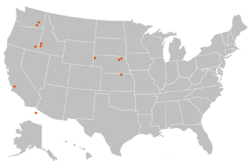Biology:Castor californicus
| Castor californicus Temporal range: late Miocene to early Pleistocene
| |
|---|---|
| Scientific classification | |
| Domain: | Eukaryota |
| Kingdom: | Animalia |
| Phylum: | Chordata |
| Class: | Mammalia |
| Order: | Rodentia |
| Family: | Castoridae |
| Genus: | Castor |
| Species: | †C. californicus
|
| Binomial name | |
| †Castor californicus Kellogg, 1911[1]
| |

| |
| Sites of C. californicus finds | |
| Synonyms | |
Castor californicus is an extinct species of beaver that lived in western North America from the end of the Miocene to the early Pleistocene.[2] Castor californicus was first discovered in Kettleman Hills in California , United States . The species was similar to but larger than the extant North American beaver, C. canadensis.[4]
Unlike other members of the Castor genus, the Castor californicus has a total of three enamel folds.[5]
The Castor californicus has been determined to be the earliest type of its genus to appear in North America.[citation needed] Castor californicus is characterized by having short nasal passages. The backs of their skulls were quite wide in comparison to other members of the Castor genus. The coronoid process is more spread out. Their pterygoid muscles were on the larger side, and their neck muscles were broad. Due to these distinctions, Castor californicus had a slight physical advantage compared to Castor fiber. Each Castor californicus was slightly unique in its postcranial morphology. They had short femurs and elongated hind feet, which assisted them in moving with ease through water. Compared to other species of beavers, Castor californicus had considerably wide metatarsals, which aided them in the swimming and digging process.[6]
References
- ↑ Kellogg, Louise (1911). "A Fossil Beaver from the Kettleman Hills, California". Bulletin of the Department of Geology (University of California Publications) 6 (17): 401–402. https://babel.hathitrust.org/cgi/pt?id=uc1.c034382348;view=1up;seq=495.
- ↑ 2.0 2.1 "The Paleobiology Database - Castor californicus". http://paleodb.org/cgi-bin/bridge.pl?action=checkTaxonInfo&taxon_no=44956&is_real_user=1. Retrieved 2007-09-30.
- ↑ Hay, Oliver P. (1927). The Pleistocene of the Western Region of North America and its Vertebrated Animals. Carnegie Institution of Washington. Publication ;no. 322B. Carnegie Institution of Washington. pp. 266–267. https://babel.hathitrust.org/cgi/pt?id=osu.32435009092347;view=1up;seq=274.
- ↑ Kurtén, B.; E. Anderson (1980). Pleistocene Mammals of North America. New York: Columbia University Press. pp. 236–237. ISBN 0-231-03733-3.
- ↑ "A fossil beaver from the Kettleman Hills, California, by Louise Kellogg | The Online Books Page". https://onlinebooks.library.upenn.edu/webbin/book/lookupid?key=ha100897771.
- ↑ Lubbers, Kelly E.; Samuels, Joshua X. (2023-09-02). "Comparison of Miocene to early Pleistocene-aged Castor californicus (Rodentia: Castoridae) to extant beavers and implications for the evolution of Castor in North America" (in English). Palaeontologia Electronica 26 (3): 1–28. doi:10.26879/1284. ISSN 1094-8074. https://palaeo-electronica.org/content/2023/3943-fossil-beaver-morphology.
Further reading
- Repenning, Charles A.; Weasma, Ted R.; Scott, George R. (1995). "Castor californicus Kellogg, 1911". The Early Pleistocene (Latest Blancan-Earliest Irvingtonian) Froman Ferry Fauna and History of the Glenns Ferry Formation, Southwestern Idaho. U.S. Geological Survey Bulletin. 2105. Washington: United States Government Printing Office. pp. 26–27. doi:10.3133/b2105. https://pubs.er.usgs.gov/publication/b2105.
- Lubbers, Kelly E (2022). An Evaluation of Castor Californicus and Implications for the Evolution and Distribution of the Genus Castor (Rodentia: Castoridae) in North America (Thesis). ProQuest 2734698665.
Wikidata ☰ Q3495788 entry
 |


